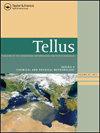年fCO2循环和亚南极洋的海气CO2通量
IF 2.3
4区 地球科学
Q3 METEOROLOGY & ATMOSPHERIC SCIENCES
Tellus Series B-Chemical and Physical Meteorology
Pub Date : 1999-09-01
DOI:10.3402/TELLUSB.V51I4.16495
引用次数: 179
摘要
亚南极带(SAZ)位于副热带辐合带(STC)和亚南极锋(SAF)之间,是大气co2最强的海洋汇之一。强汇是由大风和相对于大气co2的季节性低海面co2 (fco2)通量造成的。南中国海区域以及紧靠南的区域也受到模式和中间水形成的影响,在混合层下方产生人为co2的渗透。对同一季节和年份(1993年2月至3月)进行的连续测量的详细分析显示,南大洋印度洋板块东部(约145°E的WOCE/SR3)和西部边缘(约30°E的WOCE/I6)的co2分布具有一致的模式。东部(110°~ 150°E)和西部(20°~ 90°E)夏季均出现较强的co2汇(Δ f CO 2 < - 50 μatm)。夏季较强的co2汇是由于形成了一个浅的季节性混合层(约100 m),地表水中co2的减少与夏季生物调节的碳减少一致。在南方冬季,地表fco 2与大气接近平衡(Δ fco 2±5 μatm), co2净交换量较夏季小。冬季的接近平衡值与深层冬季混合层(高达700 m)的形成有关。1992 - 1995年,亚南极区印度洋部分(40°- 50°S, 20°- 150°E)的年CO 2吸吸量估计约为0.4 GtC yr - 1。将这一估计值外推到整个亚南极区,表明环极区域的吸收接近1 GtC年−1。DOI: 10.1034 / j.1600 0889.1999.t01 - 3 - 00008. x本文章由计算机程序翻译,如有差异,请以英文原文为准。
The annual fCO2 cycle and the air–sea CO2 flux in the sub‐Antarctic Ocean
The sub-Antarctic zone (SAZ) lies between the subtropical convergence (STC) and the sub-Antarctic front (SAF), and is considered one of the strongest oceanic sinks of atmospheric CO 2 . The strong sink results from high winds and seasonally low sea surface fugacities of CO 2 ( f CO 2 ), relative to atmospheric f CO 2 . The region of the SAZ, and immediately south, is also subject to mode and intermediate water formation, yielding a penetration of anthropogenic CO 2 below the mixed layer. A detailed analysis of continuous measurements made during the same season and year, February – March 1993, shows a coherent pattern of f CO 2 distributions at the eastern (WOCE/SR3 at about 145°E) and western edges (WOCE/I6 at 30°E) of the Indian sector of the Southern Ocean. A strong CO 2 sink develops in the Austral summer (Δ f CO 2 < − 50 μatm) in both the eastern (110°−150°E) and western regions (20°−90°E). The strong CO 2 sink in summer is due to the formation of a shallow seasonal mixed-layer (about 100 m). The CO 2 drawdown in the surface water is consistent with biologically mediated drawdown of carbon over summer. In austral winter, surface f CO 2 is close to equilibrium with the atmosphere (Δ f CO 2 ± 5 μatm), and the net CO 2 exchange is small compared to summer. The near-equilibrium values in winter are associated with the formation of deep winter mixed-layers (up to 700 m). For years 1992–95, the annual CO 2 uptake for the Indian Ocean sector of the sub Antarctic Zone (40°−50°S, 20°−150°E) is estimated to be about 0.4 GtC yr −1 . Extrapolating this estimate to the entire sub-Antarctic zone suggests the uptake in the circumpolar SAZ is approaching 1 GtC yr −1 . DOI: 10.1034/j.1600-0889.1999.t01-3-00008.x
求助全文
通过发布文献求助,成功后即可免费获取论文全文。
去求助
来源期刊
自引率
0.00%
发文量
3
期刊介绍:
Tellus B: Chemical and Physical Meteorology along with its sister journal Tellus A: Dynamic Meteorology and Oceanography, are the international, peer-reviewed journals of the International Meteorological Institute in Stockholm, an independent non-for-profit body integrated into the Department of Meteorology at the Faculty of Sciences of Stockholm University, Sweden. Aiming to promote the exchange of knowledge about meteorology from across a range of scientific sub-disciplines, the two journals serve an international community of researchers, policy makers, managers, media and the general public.

 求助内容:
求助内容: 应助结果提醒方式:
应助结果提醒方式:


